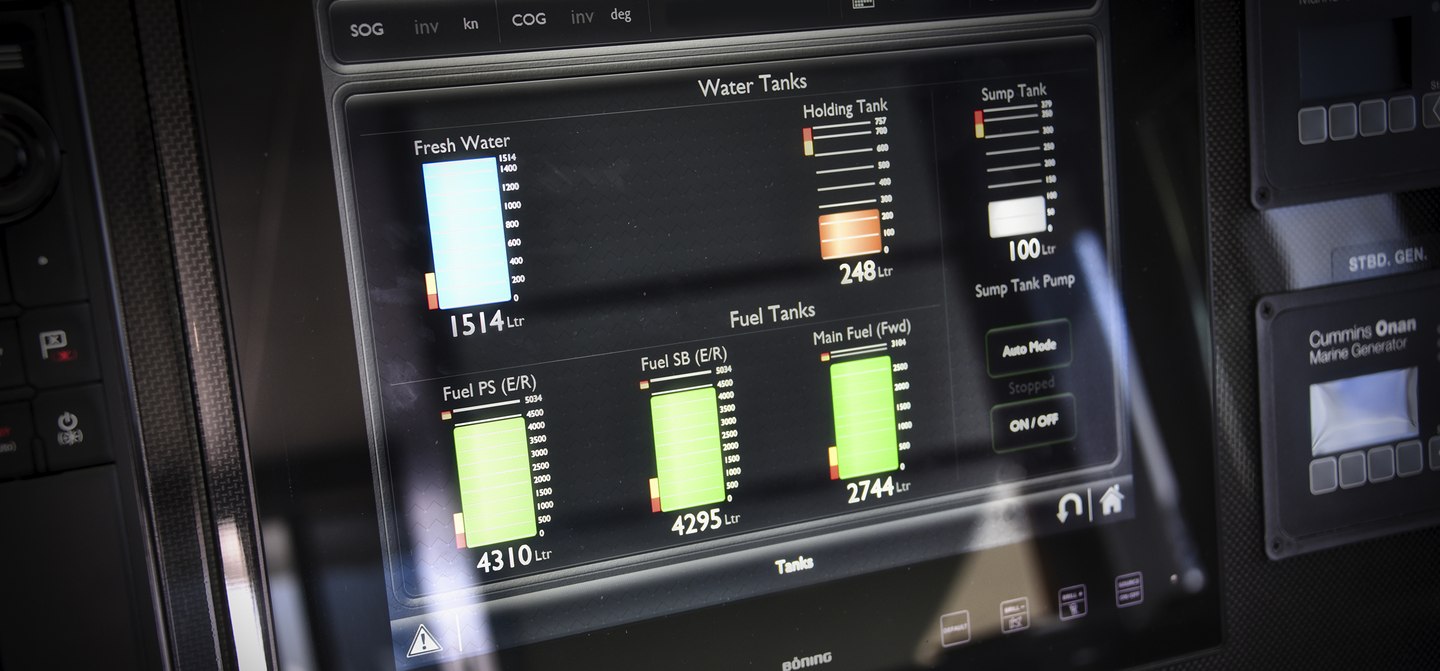When it comes to life onboard there are a lot of choices to make. Below you'll find sections on domestic equipment, including heating, lighting, air conditioning, cooking, and refrigeration appliances.
There are many things that enhance the quality of life onboard. Some of them we naturally take for granted on dry land, such as unlimited hot and cold running water, mains electricity, flushing toilets, ice on demand, and other domestic systems that keep us comfortable at home. It requires a considerable amount of complex and specialized equipment to provide mod-cons onboard a yacht.
This article provides an overview of the core domestic systems you should expect to find onboard and also explains how they’re different from the ones we use at home. It’s worth knowing about these systems when you’re comparing models and deciding which yacht to buy, or ticking the options list after making the all-important buying decision.
Once you’ve bought your yacht — and especially if you are planning to do some of the maintenance work yourself or cruising in the open sea — we strongly recommend having a copy of Nigel Calder’s book, Boatowner’s Mechanical And Electrical Manual, onboard.
Power Onboard
Mains Electrical Power
Most modern yachts have normal plug sockets in the salon and cabins so you can plug in things like phone chargers, hairdryers, laptops, toasters, and so on.
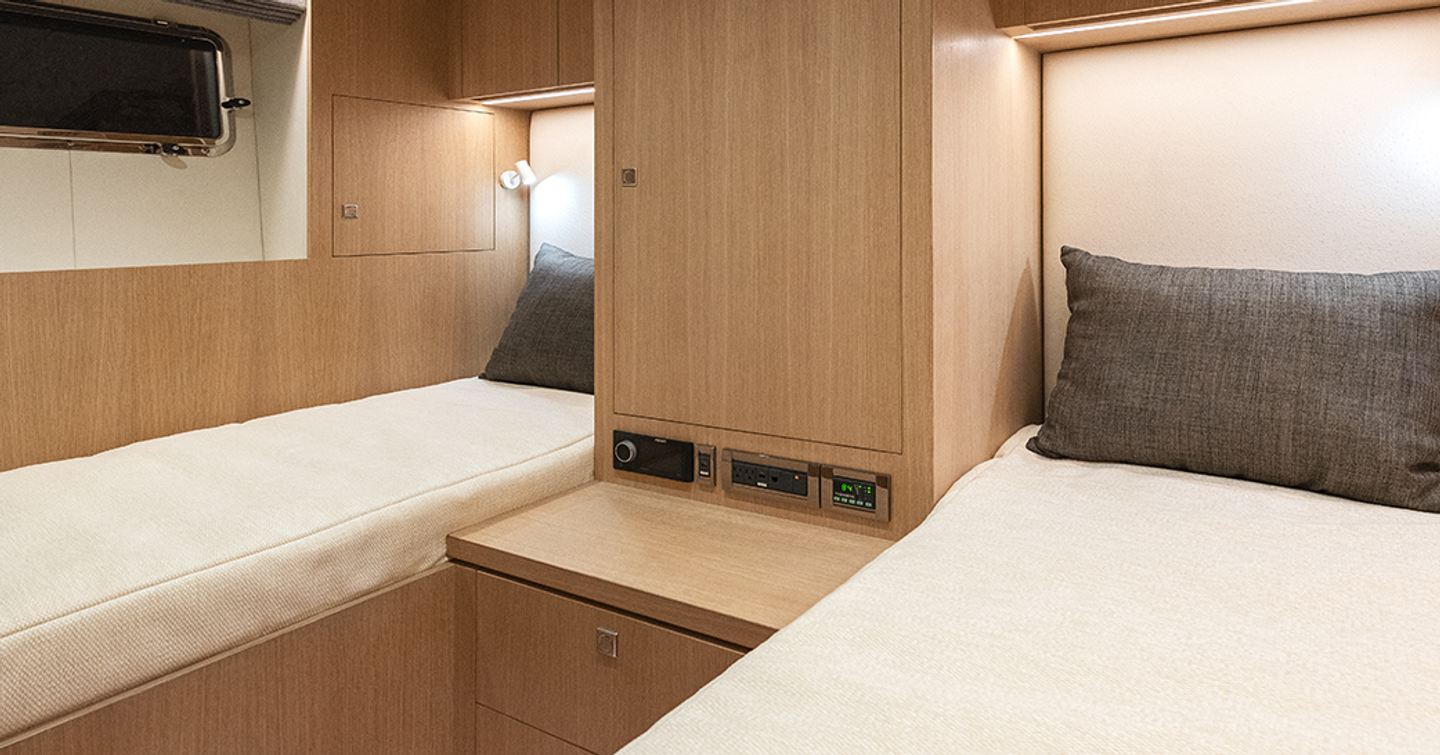
That’s no big deal when the yacht is in a marina and connected to shore power, but mains electricity won’t be available when you’re anchored in a quiet bay or moored alongside a rustic jetty so you’ll be relying on an onboard system to provide the power.
Generators
Essentially there are two options, and many yachts have both. The most common solution is to have a diesel or petrol-powered AC generator installed in the engine room. These units can be relatively inexpensive and simple to fit but are noisy.
It’s a common bugbear of yacht owners at anchor to be woken up in the middle of the night by the drone of a generator. So, if you plan to anchor with or near to other yachts, maybe consider another option.
Inverters
The other option is a DC-to-AC inverter. This draws 12V DC power from the yacht’s batteries (24V or 48V on larger yachts) and converts it to a 110V or 220/240V AC current.
The major advantage of inverters is that they’re silent. The big drawback (especially with cheap ones) is that they can be very inefficient. A hairdryer or kettle powered by a poor-quality inverter can drain the batteries of a small or medium-sized yacht in a surprisingly short time.
Pure sine wave inverters are much more expensive but in practice, they’re the only ones suitable for use on yachts. Some builders fit top-notch inverters as standard while others don’t, so it’s worth checking.
Domestic Batteries
Most yachts have some sort of battery management or monitoring system installed to avoid flat batteries. For complete peace of mind, having two completely separate battery banks onboard can be advantageous, with one used for cranking the engines and the other for powering domestic systems.
Lighting
You should expect any new yacht to be fitted with low-power LED lights that can run off the yacht’s batteries for days on end without too much fuss while also returning a good life span.
Until recently, many builders would fit high-power halogen lights instead because they cast a warmer light, giving potential buyers a better first impression of the salon and cabins.
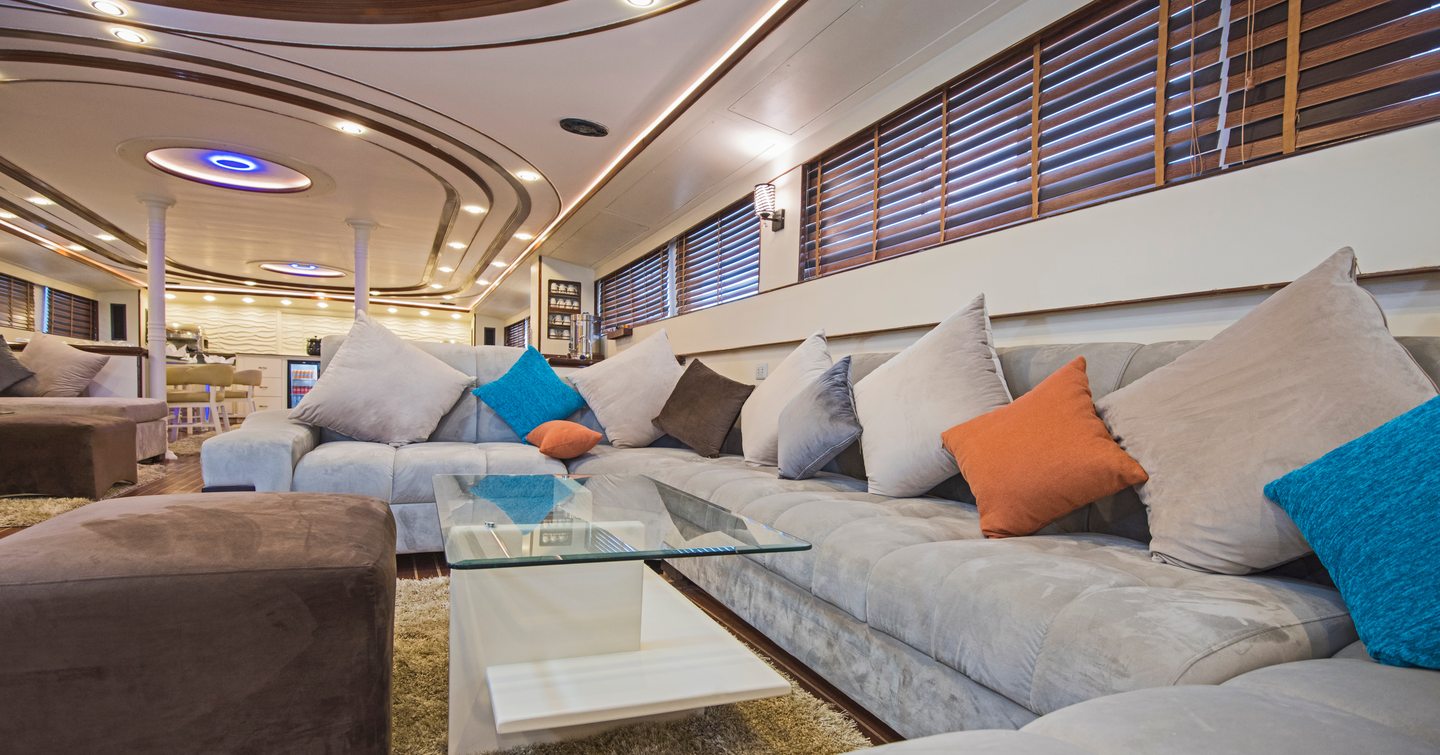
If you’re buying a second-hand boat that’s ten years old or older, you may find all the light bulbs are halogens, and if so, it’s a good idea to replace them. If that means replacing all of the light fittings as well as the bulbs, it could be expensive.
Away from the more serious aspects of consumption, longevity, and seeing where you are going, lighting today delivers another key onboard feature — decoration. As we have said, yacht builders would use warmer bulbs to create a sense of comfort. Today’s yachts have progressed far beyond that point with multiple mood-lighting options being used in addition to stylistic elements.
Climate Control
Controlling the onboard environment has become a more sophisticated and user-friendly experience. Heating systems are now often standard fit items, particularly on North European-built yachts.
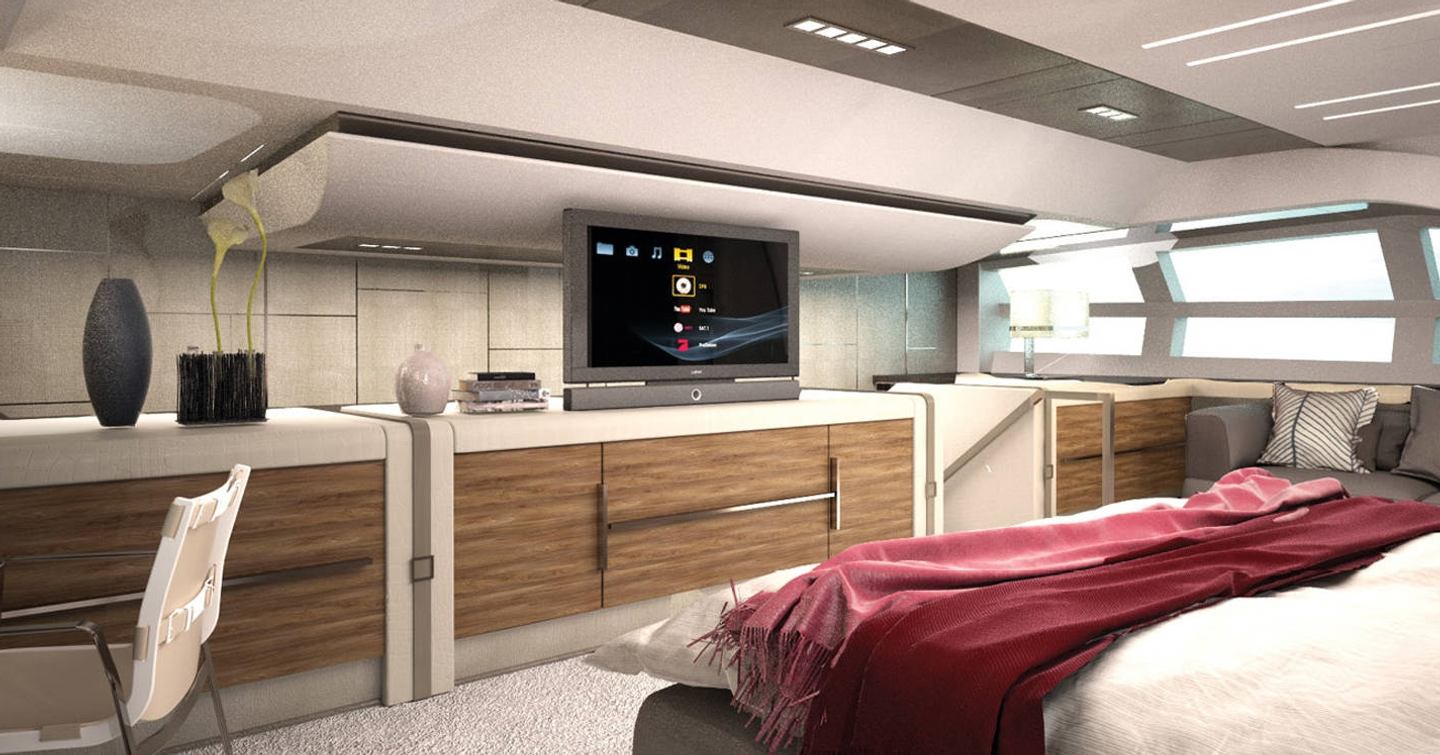
Efficient Air-Con
Air-conditioning has moved from being a moderately rare luxury to an almost standard-fit item. Despite this, you may still need to pay extra to have it onboard some production yachts.
Many yacht owners cruising in hot climates have to choose between running a noisy generator all night or turning off their air conditioning when they aren’t connected to shore power. The solution used to involve doubling the size of the yacht’s battery bank, but there’s no longer any need to do that. The latest generation of inverter variable capacity air conditioning systems are so efficient that they can be run all night at full power while drawing little more than one amp-hour.
Self-contained inverter units (which are the easiest type to retrofit) are about 40% more efficient than conventional ones, and the bulkier chiller-type inverter units are 45% more efficient.
Heating
If you keep your yacht in a temperate climate with a cold season, you may want heating as well as air conditioning. Some of the latest air conditioning systems are efficient enough at heating to do both very effectively.
If you’re boating in a colder climate, you might not need air conditioning but you’ll want a heater. There are various types. The most common is a marine version of the standard modern truck or camper van heater — a blown air heater — which burns diesel to generate heat and uses electricity to drive a fan that blows the hot air out of ducts and into the cabins and salon. The two best-known brands are Eberspächer and Webasto, but cheaper, less well-known brands are also available.
If you keep your yacht in a temperate climate with a cold season, you may want heating as well as air conditioning."
Premium versions are also available, such as very neat and well-engineered systems made by Wallas. You can get blown air heaters that run on paraffin rather than diesel and these may be worth considering if your yacht runs on petrol.
Blown air heaters need regular use and require servicing every few years, or they’re likely to stop working. The marine versions of these units cost a lot more than the ones designed for trucks and campers but don’t be tempted to use automotive-grade equipment. Various parts of the system will be prone to corrosion in the marine environment and most yacht surveyors regard them as a fire hazard.
Venting and Exhausts
While on the subject of fire hazards, if you’re buying a boat with a blown air heater installed, be sure to check where the exhaust is.
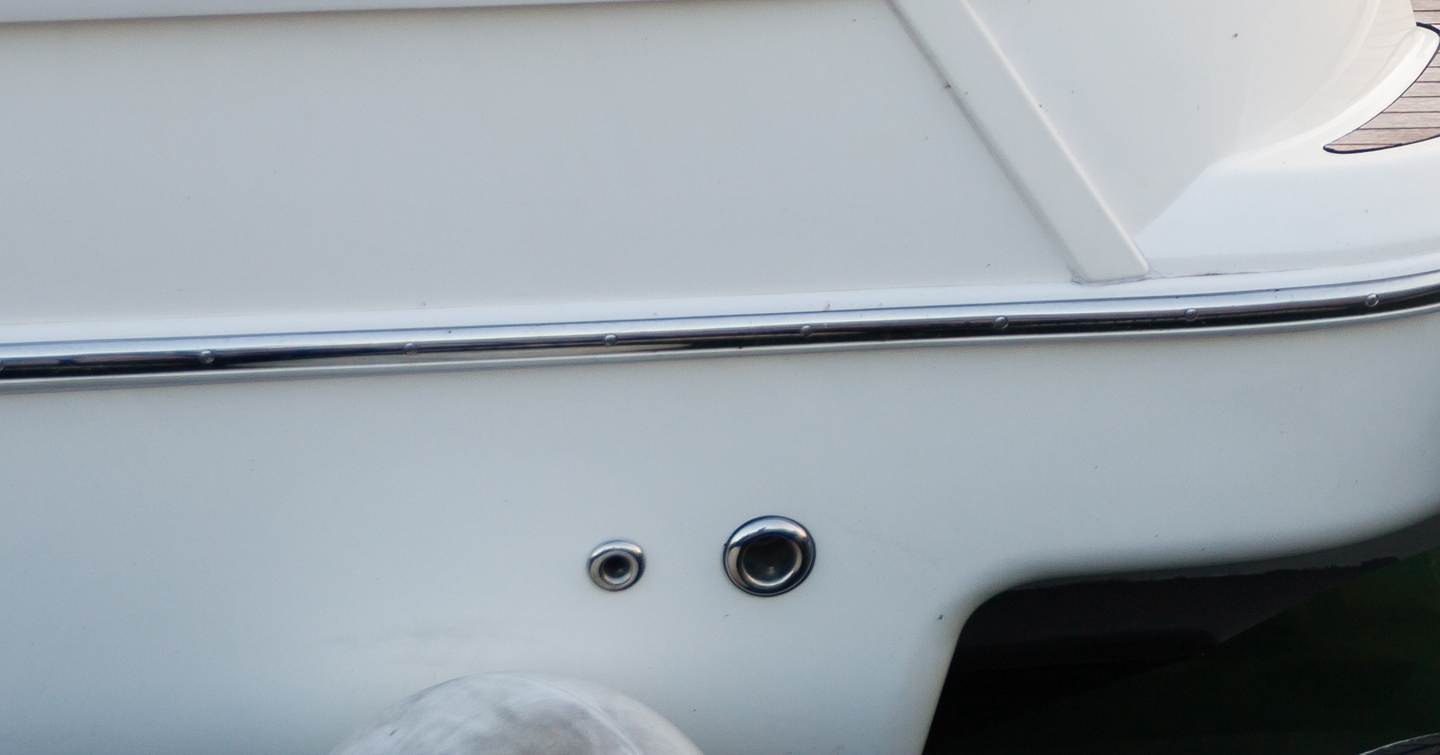
It’s not unusual to see a heater exhaust fitted in a yacht’s topsides, which is a very bad place to put it. When the yacht is berthed alongside another boat it’s very likely to upset the neighbors by spewing diesel fumes into their cockpit or cabin. There may also be the added risk of melting fenders.
Marine Stoves
Traditional-style cabin heaters, such as a Taylor's stove, would be out of place on a sports cruiser but are worth considering for some types of modern motor yachts. They’re attractive-looking, high-quality pieces of kit, still popular among canal boat owners and other liveaboard cruising folks because of the low maintenance and the ambiance of a fireplace.
This sort of heater includes variants that run on diesel, paraffin, or even coal. They all need to be installed against a well-insulated bulkhead with a flue going up through the deck.
Hull Color and Insulation
Whatever sort of air conditioning or heater you have (or even if you have neither) it’s worth thinking about the hull that wraps it all up.
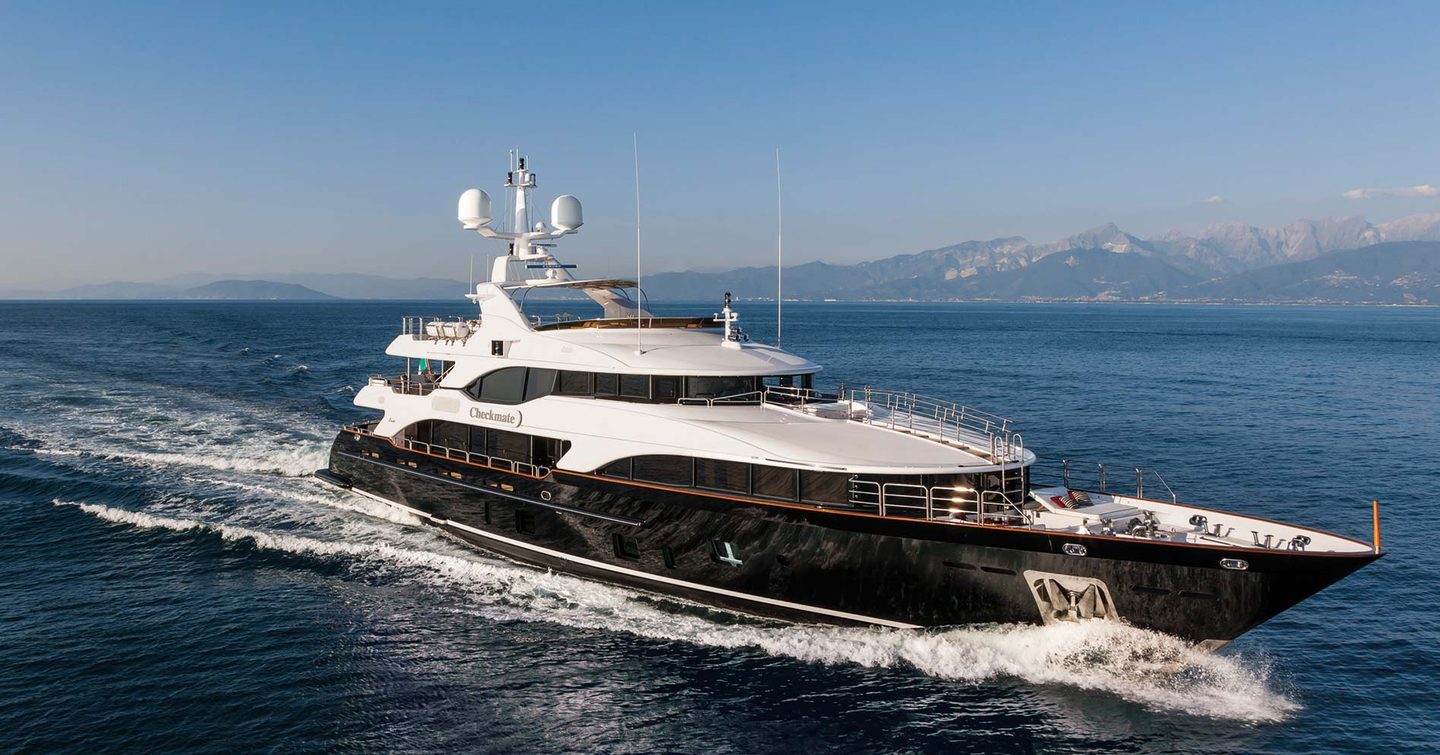
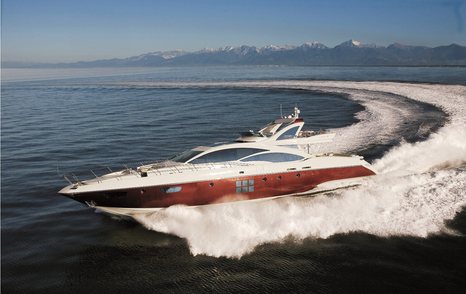
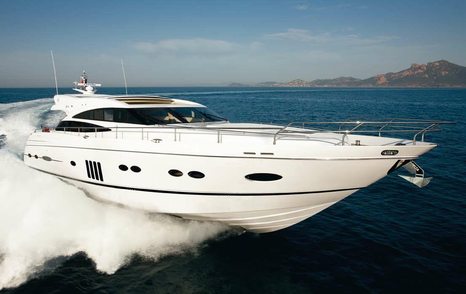
Hull colors have become very popular, but a dark hull will absorb the heat far more and require the air-conditioning to work a lot harder. So much so, that hybrid yachts can be heavily affected in their performance by air-con requirements. If you’re cruising in hot climes, a light or white hull is far more efficient.
A well-insulated hull is easier to heat or cool effectively, is much less prone to condensation (metal hulls are notoriously prone to this), and reduces the disturbance from other yachts’ engines, thrusters, generators — and parties. The yacht next to yours may be just two feet away and sound travels through water very easily. In a similar vein, double or even triple glazing can be a worthwhile option, especially on a yacht with large windows.
Water and Tankage
As the old adage goes, 'Water, water everywhere, but not a drop to drink’. When out at sea, it’s surprisingly easy to run out of fresh water.
At home, a shower with decent water pressure uses around 18 liters (four gallons) of water per minute. It follows that if four people onboard each have a ten-minute shower in the morning and then they each use the cockpit shower for a three-minute rinse after swimming, you’ll have used 936 liters (206 gallons) of water.

A typical 50ft yacht might only have 640 liters (170 gallons) of capacity in its freshwater tanks, so even if you’re only out for a weekend with a couple of guests, it’s nowhere near enough. This is also without considering other water requirements, such as washing dishes after meals.
Water-Saving Tips
Many modern yachts combat this usage by fitting water-saving shower heads, although they aren’t very pleasant to use. Using a marina’s shower facilities or simply showering as quickly as possible onboard are the two best ways to cut water use.
It is certainly worth reviewing the water (and fuel) tank capacities of the yachts you are considering. Some builders will fit small tanks to maximize interior space and save on weight. The other side of the equation is that bigger tanks will affect the yacht’s fuel economy and performance.
Watermakers
This is why watermakers, which use a reverse osmosis process to turn seawater into drinking water, have become popular optional extras on large yachts in recent years. They’re certainly useful but aren’t cheap, tend to produce water at a slow rate, and need regular servicing and maintenance.
Water Heaters
The yacht equivalent of the domestic boiler is the calorifier. This is essentially the same thing — an insulated copper cylinder with an electric immersion heater — but it is also heated by the water that cools the yacht’s engines whenever you’re underway.
Greywater Waste
Increasingly, yachts are expected to carry their own waste or grey water (from showers, dishwashing, and so on) back to the harbor and get rid of it at an official pump-out station, rather than simply draining it overboard. Most inland waterways have strict rules and many countries have banned greywater discharge in their coastal waters too. Whatever the size of a yacht’s fresh water tank, its grey water tank should be at least that size too.
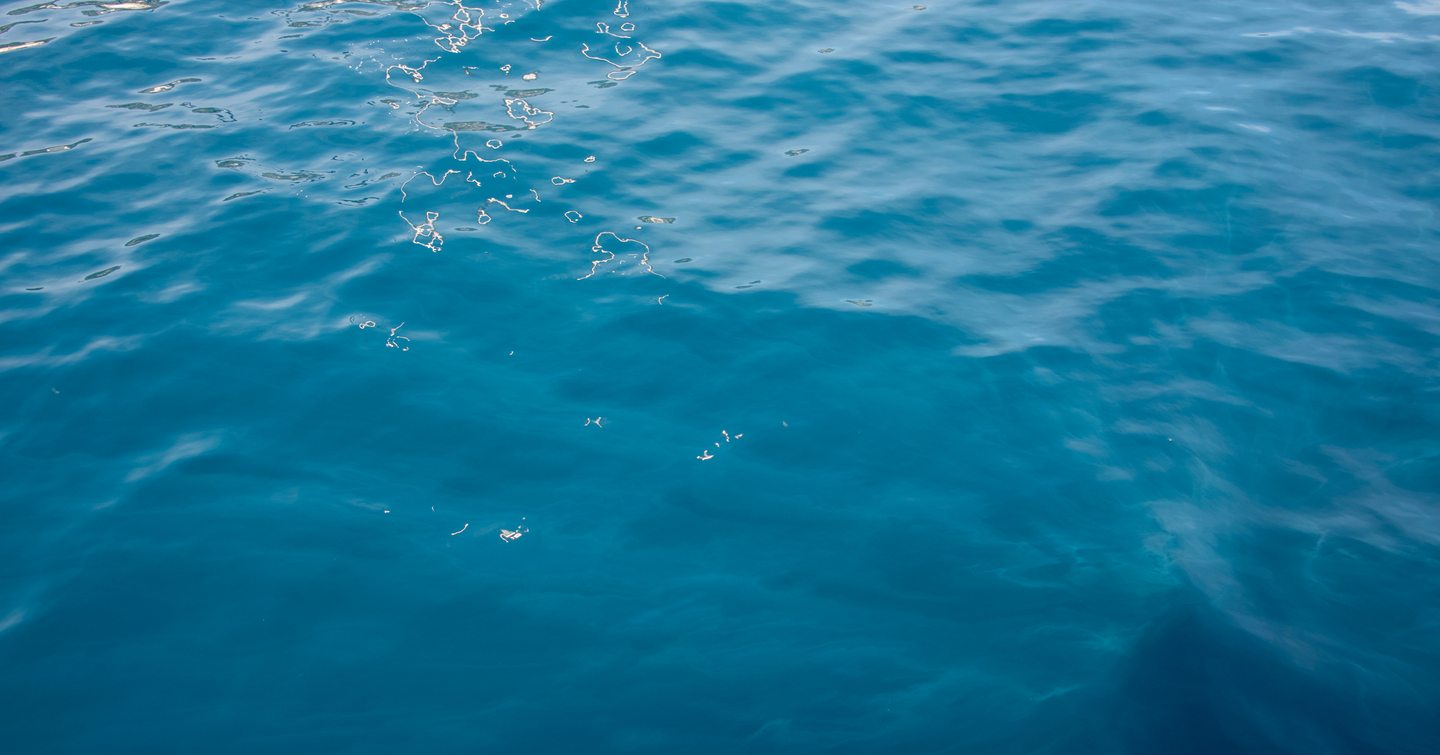
Tanks
Not long ago, high-quality yachts had water tanks made of high-grade stainless steel and cheaper yachts had fiberglass tanks. Nowadays, many yachts at a wide range of price points have flexible plastic tanks or giant bladders instead.
Steel and flexible plastic both have their pros and cons. Steel tanks are more durable and should last longer, but cost a lot more to fit and are a lot more work to replace if required.
Flexible plastic tanks are a lot cheaper and simple to replace, but are more easily punctured and thus arguably less suitable for small, fast sea-going yachts. When it comes to steel or fiberglass tanks, the thing you need to check is access. You want decent-sized inspection hatches to ensure they can easily be cleaned.
Most domestic water systems use gravity to create water pressure but yachts tend not to have large header tanks because all that weight high up would affect their stability. Instead, they have their water tank down low in the bilge where it acts as ballast, and use pumps to create water pressure.
These pumps can be noisy and it’s not unheard of for builders to put them under the floorboards of a master or guest cabin, where they’re likely to disturb a light sleeper when someone else turns a tap on. When looking around a yacht, it’s worth turning on a few taps to check the noise levels.
Sea Toilets and Holding Tanks
Sea toilets are quite different from the ones we use ashore. On small and medium-sized yachts, they’re often flushed manually by pumping a handle and turning a valve (or sometimes two).
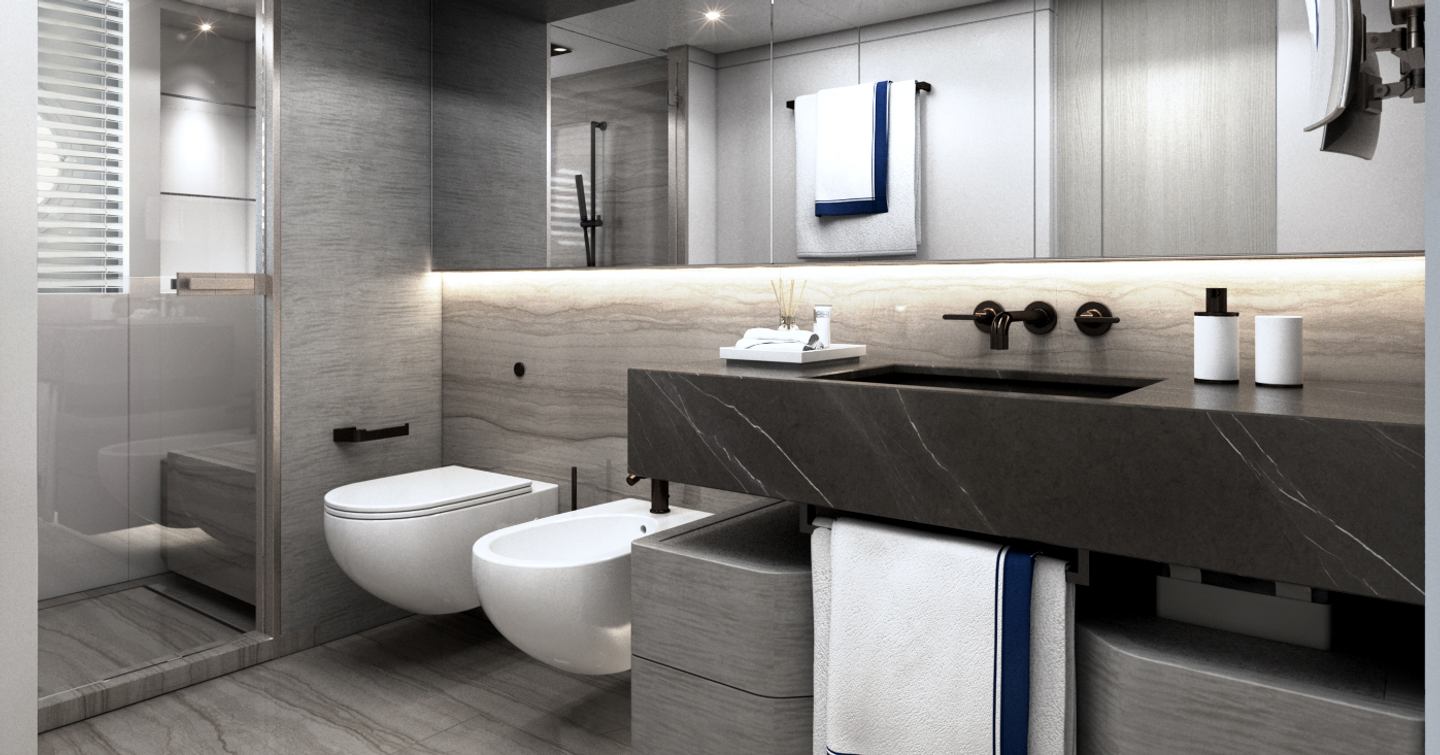
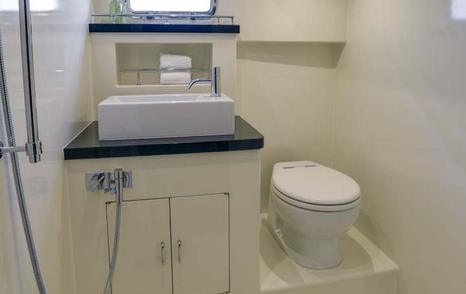
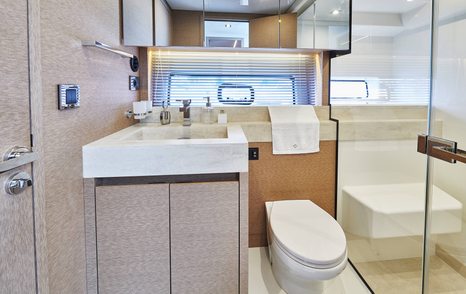
There are three types of manual sea toilets, Jabsco, Lavac, and Blakes, each with its own distinct pros and cons. Jabsco and Blakes are more prone to generating nasty smells as they have more places for bacteria to live. Lavacs usually smell better but are a bit trickier for a first-time user to operate.
Larger and more luxury yachts generally have electric flush toilets. These are much more like toilets ashore from a user’s perspective but the plumbing requires more complex maintenance.
All yachts should be fitted with a holding tank, where waste can be safely stored before it is pumped out, ideally at a pump-out station. If rules and regulations allow it, this can also be ejected out at sea.
The Galley
Galleys come in all sizes and styles, offering various levels of catering sophistication. So, the most important consideration for a yacht’s galley is how it’s going to be used. Do you want to make dinner or just a quick sandwich? How much space do you need for cooking and stowage?
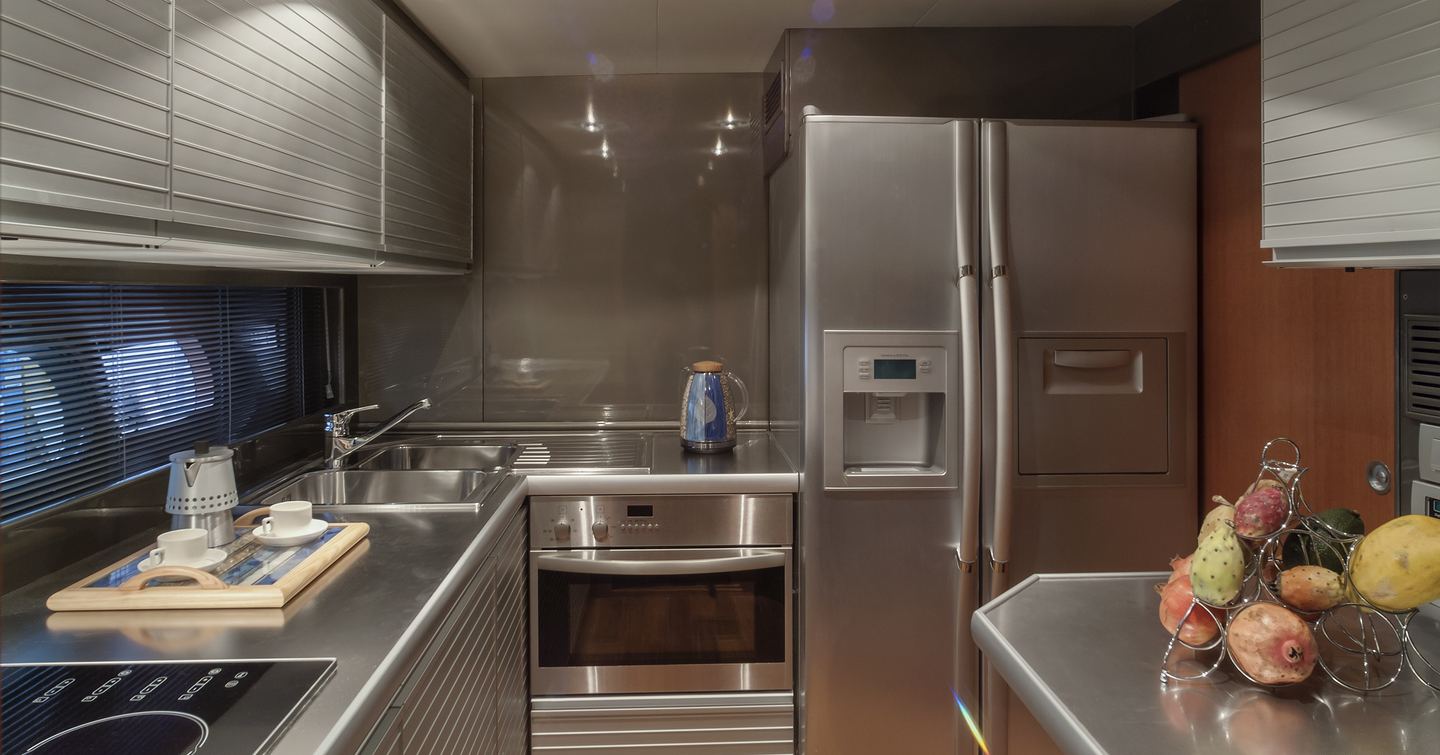
On a fast planing yacht, it’s unlikely to be used much when you’re underway, and especially not at high speeds. Unless you’re into fishing, you probably won’t want to use it while the yacht is rolling on an ocean swell. If you’re only going to use the galley in harbors and very sheltered anchorages, its layout is simply a matter of the cook’s personal preference.
Layout and Design
There are three basic locations for a galley, centrally or aft at deck-level, or below deck.
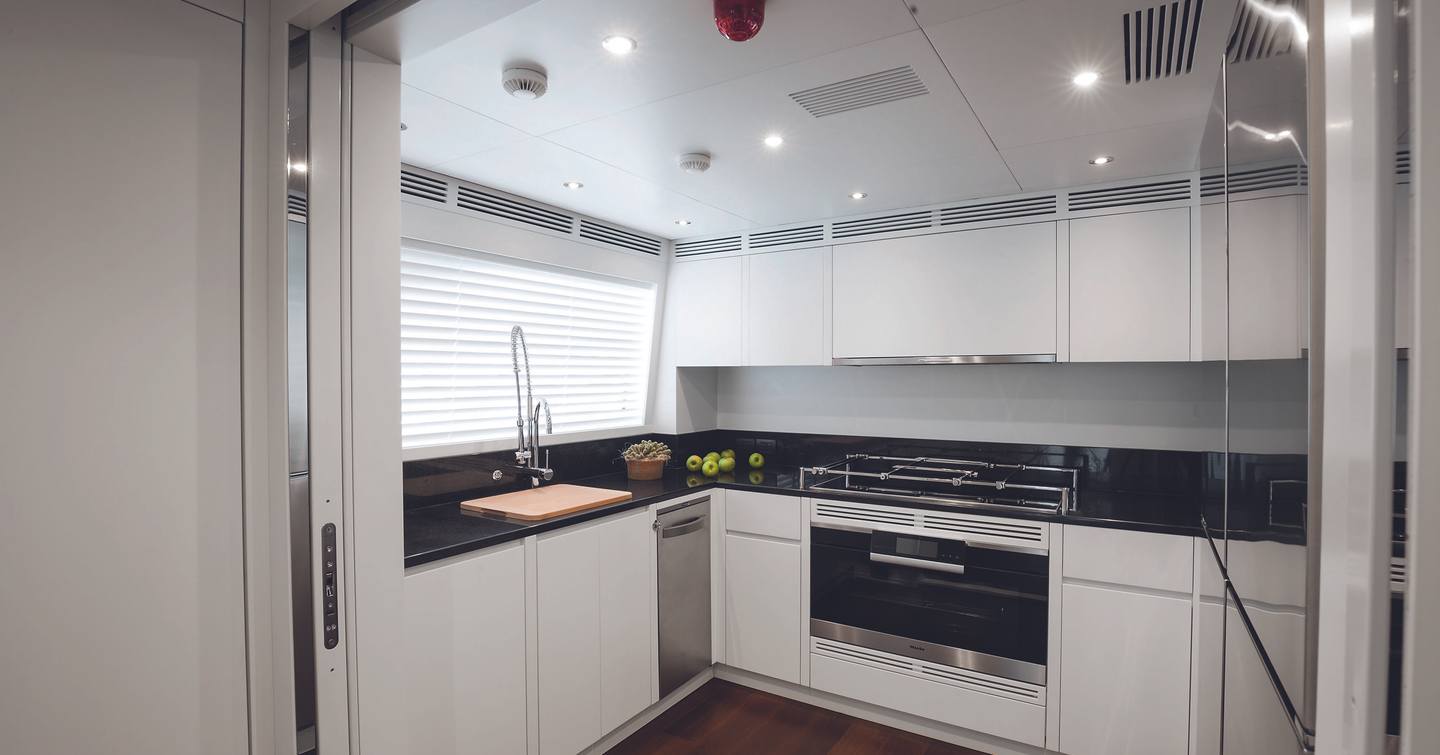
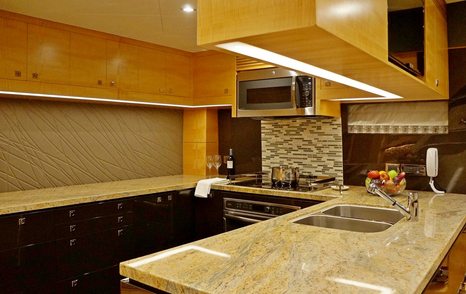

Having a galley at deck level creates easy access and serving but can make the galley part of the social area, while a below-deck version hides away the cooking, plates, and general leftovers. If space allows, the general move is for a deck-level layout, with aft galleys now very popular, freeing up space below for sleeping accommodation.
For a long-distance yacht, there are other considerations. If you’re likely to be cooking or using the galley in open water, it’s useful (and safer) to have an L-shaped galley where you can brace yourself against the motion of the boat.
The galley worktops should have raised edges called fiddles, which stop things from sliding or rolling off when the boat rolls.
Specialist Stowage
Stowage is another matter. Nearly all yachts have dedicated stowage for crockery, glasses, and wine, keeping these items snugly in place when underway. Be sure to check that there’s enough space in cupboards and drawers to stow all the pots, pans, utensils, ingredients, and condiments that you want to have onboard.
Cookers
Yacht cookers are usually fuelled by propane or butane gas despite the obvious potential safety hazard. Any gas leak will end up in the bilge so it’s absolutely crucial to have a reliable gas alarm onboard.
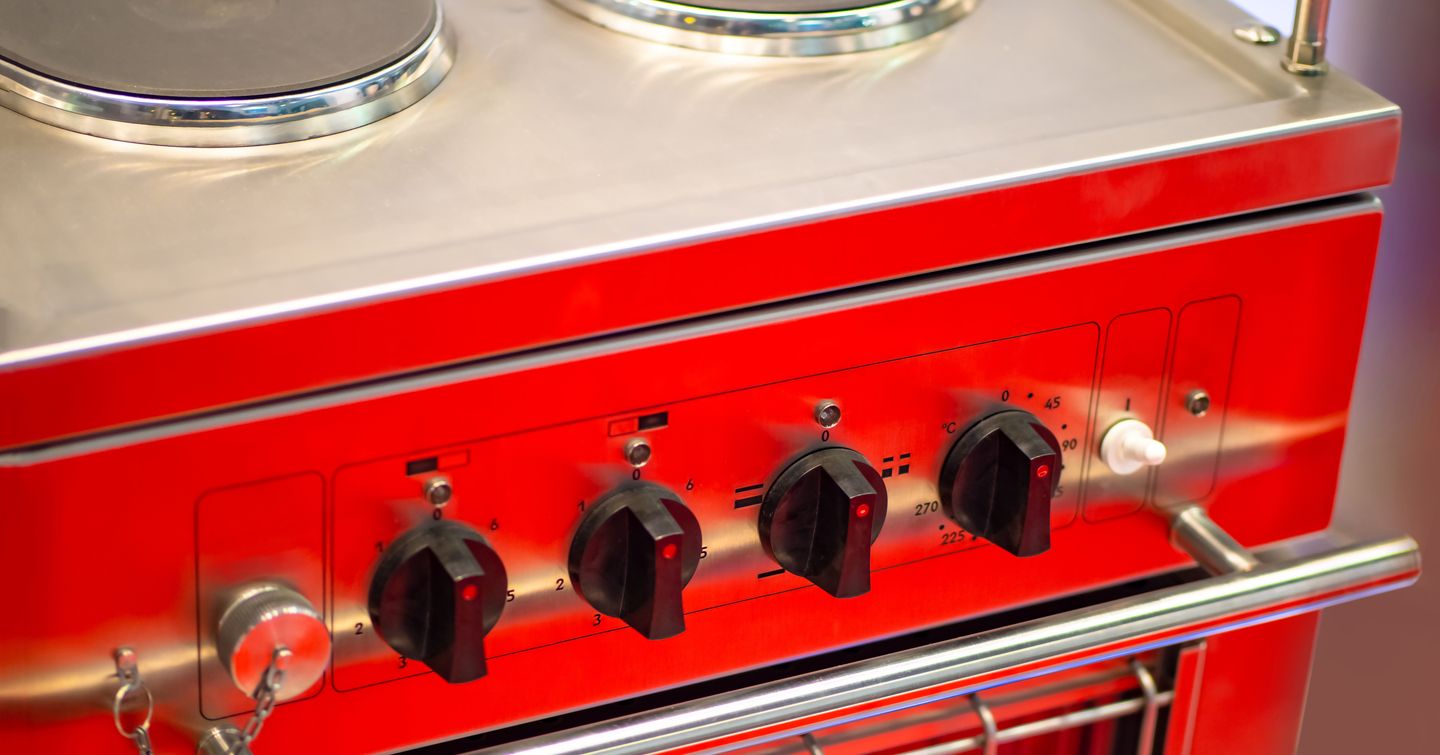
It’s a very low risk if you’re careful and the yacht’s gas plumbing is professionally fitted and maintained, but if you’re worried about it, paraffin and diesel-fuelled cookers are available for smaller yachts, and electric cookers for larger ones.
Larger yachts can run a microwave via a generator, an inverter, or off the yacht’s batteries if it’s a 24V system, but this requires a lot of power.
Refrigeration
Refrigerators, freezers, and icemakers are key appliances. With most people spending a night or two onboard, the ability to store fresh food and drinks is key. Whilst for longer stays, a freezer becomes more important.
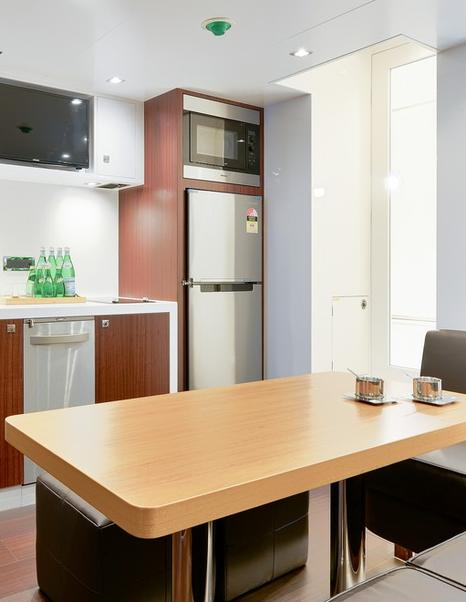
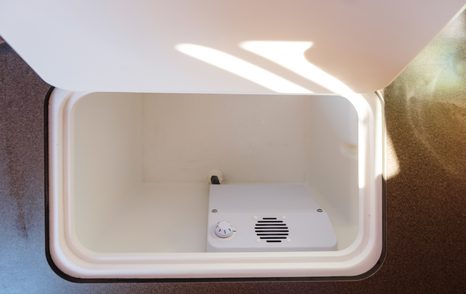
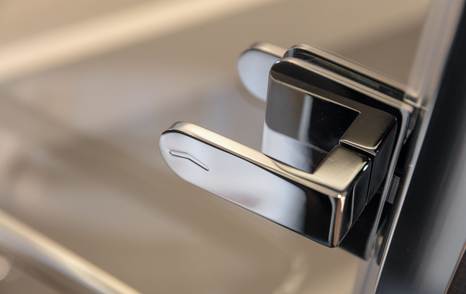
Depending on the size and style of the yacht, there could be multiple fridges, cool boxes, or icemakers to serve guests. A flybridge should have its own cold storage, as should the aft and forward cockpits on larger yachts.
Most marine fridges and freezers run on 12V or 24V from the yacht’s batteries. Front-loading fridges including neat drawer-style units, are now very common, with larger yachts able to offer full cabinet-style fridge-freezers.
If you’re going to be living onboard for long periods of time, it may be worth considering a keel-cooled fridge-freezer system as these are more energy-efficient.
Washers
Washing machines and dishwashers are rarely seen on small-to-medium-size yachts because they take up space and use a lot of fresh water and electrical power.
Most marinas have laundromats anyway, so most boaters don’t actually need a washing machine onboard their vessel.
For large yachts and superyachts, there are plenty of marine-spec options, including some from well-known premium household brands such as Miele.
